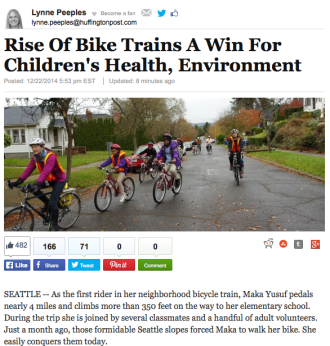
The Huffington Post has a great profile of some of Seattle’s bike to school efforts and research by Seattle Children’s to learn more about its effects on students.
We have written many times about Seattle’s bike to school revolution. It’s one of the coolest things happening in the city in recent years as schools and parents work to make it possible for students to get to school under their own power.
Great community organizing, leadership from major organizations and new city investments in Safe Routes to School are not only changing the way kids get to school all around the city, but also how healthy they are and how ready they are to learn when the class bell rings.
Seattle Children’s researchers are trying to learn more about the effect of a bike train program on students health. We reported previously about the research project, led by Dr. Jason Mendoza and Maya Jacobs. Huffington Post reports that their first research effort is entering the number crunching phase, and they already have hopes to expand it:
As the first rider in her neighborhood bicycle train, Maka Yusuf pedals nearly 4 miles and climbs more than 350 feet on the way to her elementary school. During the trip she is joined by several classmates and a handful of adult volunteers. Just a month ago, those formidable Seattle slopes forced Maka to walk her bike. She easily conquers them today.
…
“Bike trains seem like a small-scale local solution to some huge global issues we are facing right now,” said Maya Jacobs, a bike train leader and researcher at Seattle Children’s. “And kids somehow just love biking to school. Even in pouring-down rain, they think this is the best thing ever.”
Maka’s bike train represents the second phase of Mendoza’s research project. As the researchers did with a separate pair of Seattle-area schools in the spring, students from Madrona K-8 and Dunlap Elementary School were outfitted with activity and GPS monitors, as well as new bikes and helmets that they can keep. Dunlap served as the control group: participating students got bikes, but did not have an organized bike train. With Madrona’s last organized bike train ride now complete, Mendoza and his team are preparing to crunch the data, and expect to have results by the spring. He added that their ultimate goal is to do a larger study — enrolling students from, say, 20 schools — across different cities, and with a variety of terrains and cultures.
The story also gives a nod to longtime bike to school advocate Anne King, who lives in Northeast Seattle and was one powerful force behind the very successful Bike to Bryant Elementary efforts:
Anne King, who runs a local bike education and consulting business, added another benefit to the list: “It teaches kids about independence.”
“It’s good for them to learn how to get places on their own, walk in their neighborhood, interact with their neighbors and community,” said King. “When you’re in a car, it’s completely different.”
Her 6th-grade son likes biking to school, she noted, partly because it is actually faster than taking the school bus. But traffic leaves King and her husband too nervous to let him ride on his own. Concerns about getting hit by a car continue to keep many kids — and adults — from choosing to bike or walk.
This is a good chance to report one of my favorite ever Seattle Bike Blog videos (featuring Anne King, in fact!):








Comments
2 responses to “Huffington Post spotlights Seattle’s bike to school movement, research”
Woo! Anne King and everyone else who does bike trains are awesome! The programs, encouragement, and events are really heartwarming and effective.
Something this misses is the fact that these parents and bike train leaders are THE best advocates for safer streets. You simply can’t argue with the people who are trying to shepherd kids to school, and worry everyday about hazardous intersections and streets. They were crucial in helping Ballard Greenways successfully advocate for the improvement of a number of intersections this year. I hope more of them get engaged in making their walking school bus and bike train routes more safe and comfortable.
Thanks everyone who is a part of this, and here’s to even more success in 2015.
Gordon Padelford
Seattle Neighborhood Greenways
It’s a nice thing and all but it seems like the conclusions that they’re drawing using gps units and motion detectors, as well as the social dimensions, are all clear and obvious results of riding a bike. We aren’t actually learning anything new here. I guess those who support the car culture require hard data instead of common sense to refute a position that is clearly a symptom of a sick society. Which is a problem in itself, it encourages head in the sand thinking and presumes critical thinking is a lost resource.